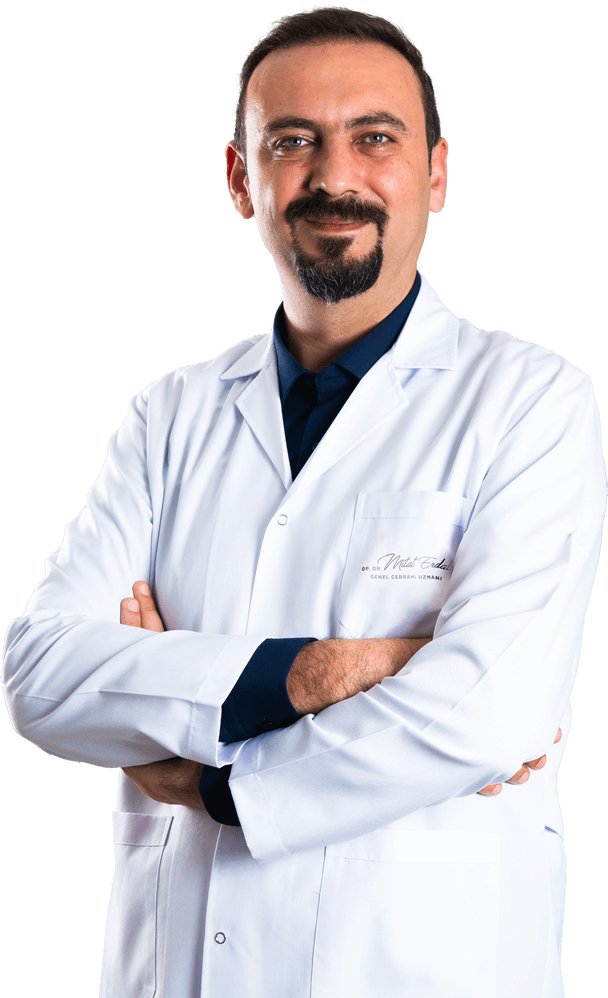Surgery can be applied especially to people with BMI over 35 + additional disease or BMI over 40 without disease.
The most common reason is that the diet and exercise programme is not effective. We organise these in the first place. If it is not enough, other methods can be tried.
Clot and leakage risk are the most fatal complications. For this reason, we minimise the risk of clots by using both blood thinners and compression stockings. For leakage, the safest material is used. We perform a leakage test with blue water both during surgery and 1 day after surgery.
Obesity is blamed for many diseases, especially diabetes, hypertension, heart diseases and sleep apnoea syndrome. All of these improve after treatment.
In patients with BMI>50, which we call super obese, weight loss is absolutely necessary before surgery. For this, we apply gastric botox to our patients if necessary and plan the surgeries in the ongoing process by reducing the risk of surgery.
The most common reason for weight regain is not following an effective nutrition and exercise programme. Of course, as in every treatment, there is a low probability of failure. However, it should not be forgotten that even in this group, the drugs used for diseases such as diabetes and hypertension are used in lower doses, that is, indirect benefits are provided again.
At least 50% of the excess weight is lost within 1 year. Most of this occurs within the first 3 months.
Diabetes is largely improved with obesity surgery. In fact, most of the patients are discharged from the hospital without medication.
The operation usually takes between 40-70 minutes. The risk of surgery varies according to the additional diseases of the operated person. Studies show that the complication rate of surgery is 3-5% and the mortality rate is 0.5%.
- BMI= Weight (kg) / height (cm)²
- 20-25= Normal
- 25-30= Overweight
- 30-35= 1st Degree Obese
- 35-40= 2nd Degree Obese (Morbit Obese)
- 40— -= 3rd Degree Obese (Super Obese)
- “First week “Clear Liquid” period
- 2. week “Soup Period”
- Week 2-4 “Puree Period”
- Week 4-6 “Soft Food Period”

Trapping of intra-abdominal organs in the hernia area. Although it is most common in the small intestine, it requires emergency surgery due to impaired blood flow.
Increase in intra-abdominal pressure intensifies hernia formation. The only treatment option after hernia formation is surgery. It does not resolve spontaneously.
Our first preference in every surgery is closed, i.e. laparoscopic surgery. However, if the patient has had a previous surgery or if there is a condition that prevents us from inflating the abdomen (severe heart failure or lung disease), closed surgery is not suitable.
We generally prioritise closed surgery.
Conditions such as constipation, heavy physical activity and prostate in particular increase intra-abdominal pressure and cause hernia formation. In addition, congenital tissue weakness, some genetic diseases and old age can also cause weak tissues and hernia formation.
Pain starting around the navel and spreading to the lower right side, loss of appetite, nausea and vomiting are the most common symptoms.
It requires emergency surgery. Laparoscopic appendectomy is performed with closed surgery.
It is the process of examining the oesophagus, stomach and duodenum with a camera through the mouth. The patient is slightly put to sleep by anaesthesia. He/she does not feel any pain.
It is a procedure in which we examine the entire large intestine through the anus. The patient is put to sleep slightly by anaesthesia. He/she does not feel any pain.
In classical treatment, some of the muscles holding the large ablution are cut. As a result, most of the patients experience gas and liquid faeces leakage in the following period. With Botox injection, the possibility of leakage is eliminated while the patient is treated without cutting the muscle.
It is safely applied especially in the treatment of stage 2 and 3 haemorrhoids and provides great comfort to the patient.
Fistula surgery is sometimes performed by gradually applying threads called setons. These may cause pain in the patient. For this, we use a silicone material called super seton. With this, there is very little pain and patient comfort is at maximum level.
Most of the gallbladder polyps are cholesterol polyps and do not grow spontaneously. Non-cholesterol polyps grow and 8-10 mm is the limit of surgery for us.
There is no certain time. But if there is growth, there is a risk of cancer for 10 mm and above.
It may cause nausea depending on the polyp location. Especially in polyps that block the gallbladder flow, a surgery is required.

